Change Windows Defender Scheduled Scan Type in Windows 10
Windows Defender Antivirus uses security intelligence definitions to detect threats. Windows 10 automatically downloads the most recent intelligence available through Windows Update. In Windows 10, you can change the scheduled scan type for Windows Defender, i.e. to switch it from a quick scan used by default to a full scan, and vice versa.
Advertisеment
Windows Defender is the default antivirus app shipped with Windows 10. Earlier versions of Windows like Windows 8.1, Windows 8, Windows 7 and Vista also had it but it was less efficient previously as it only scanned spyware and adware. In Windows 8 and Windows 10, Defender is based on the Microsoft Security Essentials app which offers better protection by adding full blown protection against all kinds of malware. Microsoft is renaming the app Microsoft Defender.
Recent Windows 10 version come with is a new app called Windows Security. The application, formerly known as "Windows Defender Dashboard" and "Windows Defender Security Center", has been created to help the user control his security and privacy settings in a clear and useful way. It includes all the settings related to Windows Defender. The Security Center app is reviewed in the post Windows Defender Security Center in Windows 10 Creators Update.
You can launch Windows Security from the Start menu or with a special shortcut. Alternatively, you can access it using its tray icon.
![]()
Note: Windows 10 allows to only temporary disable Windows Defender with a special option in Windows Security. After some period of time, it will be re-enabled automatically. If you need to disable it permanently, see
Disable Windows Defender in Windows 10.
Microsoft continually updates security intelligence in antimalware products to cover the latest threats and to constantly tweak detection logic, enhancing the ability of Windows Defender Antivirus and other Microsoft antimalware solutions to accurately identify threats. This security intelligence works directly with cloud-based protection to deliver fast and powerful AI-enhanced, next-generation protection. Also, you can update definitions manually.
By default in Windows 10, Windows Defender scans your PC automatically by performing a scheduled quick scan. You can change this and make it perform a full scan instead. Here's how it can be done.
To Change Windows Defender Scheduled Scan Type,
- Open PowerShell as Administrator. Tip: You can add "Open PowerShell As Administrator" context menu.
- Type or copy-paste the following command:
Get-MpPreference |Select-Object ScanParameters. This will display the current scheduled scan type for Windows Defender. 1 means Quick Scan. 2 - means full scan.
- To change it, issue the command
Set-MpPreference -ScanParameters <value>. The valid value is 1 for Quick Scan and 2 for Full Scan.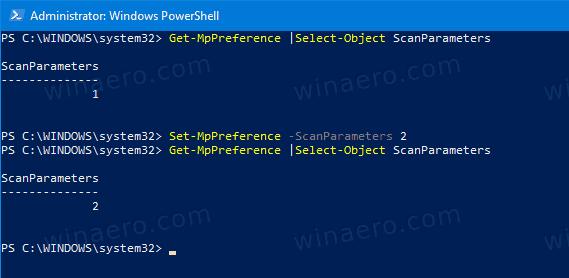
- You are done!
Alternatively, you can use a Group Policy to specify the action type for a scheduled scan for Windows Defender. If you are running Windows 10 Pro, Enterprise, or Education edition, you can use the Local Group Policy Editor app to configure the options with a GUI. Otherwise, you can apply a Registry tweak (see below).
Change Windows Defender Max CPU Usage For Scan with Group Policy
- Press Win + R keys together on your keyboard and type:
gpedit.msc
- Group Policy Editor will open.
- Go to Computer Configuration/Administrative Templates/Windows Components/Microsoft Defender Antivirus/Scan.
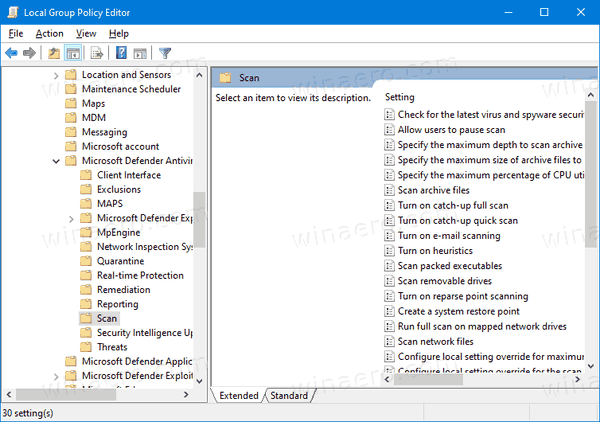
- On the right, double-click on the Specify the scan type to use for a scheduled scan policy.
- Enable this policy.
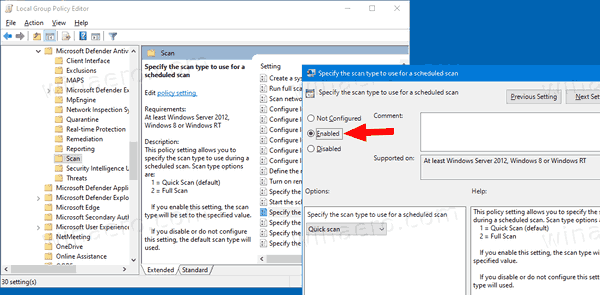
- Under Options, enter the desired scan type.
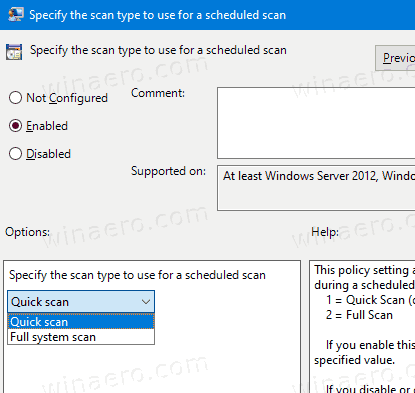
- Click Apply and OK.
Finally, if your Windows 10 doesn't include Local Group Policy Editor, you can apply a Registry tweak. Here is how.
Change Windows Defender Max CPU Usage For Scan in Registry
- Open Registry Editor.
- Go to the following Registry key:
HKEY_LOCAL_MACHINE\SOFTWARE\Policies\Microsoft\Windows Defender\Scan
Tip: See how to jump to the desired Registry key with one click. If you do not have such a key, then just create it. - Here, modify or create a new 32-bit DWORD value ScanParameters. Note: Even if you are running 64-bit Windows, you still need to use a 32-bit DWORD as the value type.
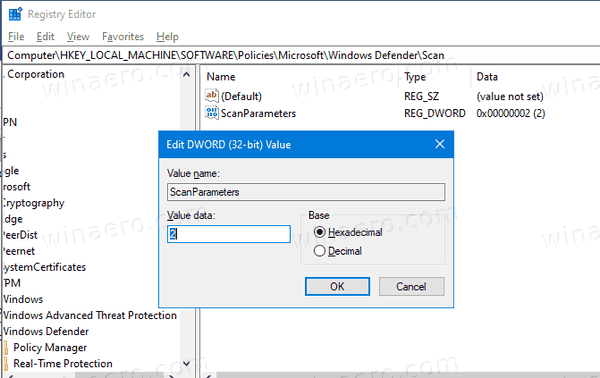
- Set the value data to 1 for Quick Scan, or to 2 for the Full Scan type.
That's it!
Tip: If you find no use for Windows Security and want to get rid of it, you may find the following articles useful:
Finally, you may want to disable the Windows Defender anti-virus app.
Related articles:
- Change Windows Defender Max CPU Usage For Scan
- Enable or Disable Tamper Protection in Windows 10
- Windows 10: View Security Providers in Windows Security
- Enable Windows Security Block Suspicious Behaviors in Windows 10
- View Protection History of Windows Defender in Windows 10
- Enable Windows Defender Sandbox in Windows 10
- Schedule Scan in Windows Defender in Windows 10
- How to Enable Windows Defender Application Guard in Windows 10
- How To Add Exclusions for Windows Defender in Windows 10
Support us
Winaero greatly relies on your support. You can help the site keep bringing you interesting and useful content and software by using these options:
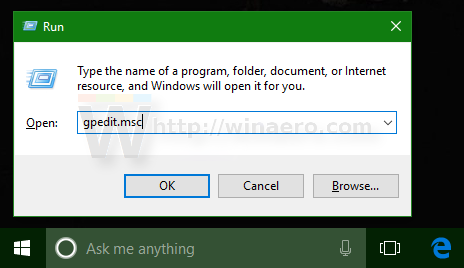

@Sergey Tkachenko
Do you know a way to disable scheduled scans that appear every 2 weeks in Windows Security with an exclamantion mark?
I don’t need them and I’d like to get rid of this reminder.
They can’t be turn off with Gpedit.
BTW, thank you for all your tips and programs, i’ve been supporting you with Paypal :)